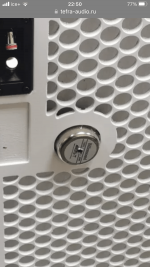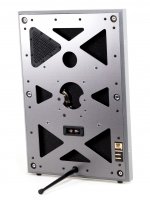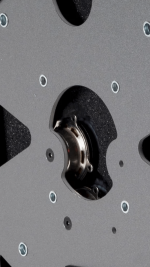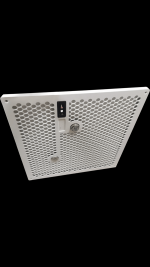The sandwich is made out of 2 x 100 mm balsa sheets glued together edge to edge.
I am using Textreme 80g/m2 for the carbon fibre skin.
The balsa and the carbon fibre skins are laminated with epoxy in a vacuum press. I’m using a vacuum press as already have one.
Sand
Thanks for the description and images. Your panel making process looks very familiar to me! I am curious about some details:
Do you make the whole panel in one bagging step, or two?
I tried several procedures, and had the best results (for me) so far with two bagging steps. First with the face carbon layer and balsa, then a second for the back layer.
One nice feature of the two step process is that I could avoid gluing the panels together first. I just taped them together from the back and laid them on top of the face layer. Then, after the epoxy cured, I could remove the tape, and sand the back of the balsa flat before applying the back layer of carbon/epoxy.
Plus, I'm too slow at spreading epoxy to get get both layers wetted before the first one starts to cure!
Glass plate on the face side?
I made my panels with heavier CF skins, but would have used the same as you or similar if I had found it at the time. Now I'm getting re-inspired to get that thinner fabric.
I'm very interested in any techniques you may have learned that helped you improve your CF/balsa bagging process.
Eric
Here is a link to a pretty good translation of the Goebel patent. Much better as I recall than what's generated by Google patents.Thank you very much for the info. I will finish translating and reading the Gobel patent tomorrow. Good night!
https://www.diyaudio.com/community/...s-as-a-full-range-speaker.272576/post-6850597
Eric
They order directly from Billionsound who makes dayton audio exciters.Any images of this claim?
Attachments
Lenta.
Are those exciters in the pictures using the new screw on feet, for easy replacement I presume?
And what is that black triangle cover in the top left ?
Steve.
Are those exciters in the pictures using the new screw on feet, for easy replacement I presume?
And what is that black triangle cover in the top left ?
Steve.
THat looks like the DAEX30HESF-4They order directly from Billionsound who makes dayton audio exciters.
Billionsound is an OEM manufacturer, and will make a product with anyone's name. They will make exciters for your specifications too. Looks like Billionsound owns all patents to products they sell as their own. Does Dayton Audio has any patents?They order directly from Billionsound who makes dayton audio exciters.
Last edited:
Billionsound's patented product list page 1 to 9. You might recognise some of them. Does Dayton Audio has any patents?
Thanks. I'll have a look at it.Here is a link to a pretty good translation of the Goebel patent. Much better as I recall than what's generated by Google patents.
https://www.diyaudio.com/community/...s-as-a-full-range-speaker.272576/post-6850597
Eric
I use Google Translate to manually translate, rather than use the auto translator. 🙂
Like @Sandasnickaren says, the Göbel patent appears to be quite similar to Danilo Herger patent, but they appear to use different scientific sounding words to explain how and why of the 'transverse' waves, and why they should be damped, and so on. Danilo Herger says to use very light honeycomb structure covered with even lighter paper. Well, you've read the patents. There's also a matter of panel's size and the type of the actuator (Danilo Herger July 2020 patent). Pity there's no scientific papers on either Herger's or Göbel's patents. On Herger's, there was a scientific paper by a husband and wife team (Karavashkin), but it appears to be taken off the internet. Herger mentions them and that thesis in his patent.
This is precisely the reason that you’ll never reach a “good” stereo soundstage !...The omni-directional power radiation in a DML will never deliver the same curve as single-point response measurement on a box. Panels will (should) radiate equal power at frequencies beyond Fc.
You make a confusion between the radiation pattern and the efficiency of a transducer… The efficiency relates to the ratio of the input and the output power. How the power is afterwards radiated is another league.Pistons cannot approach this even into half-space. This is why a single, on-axis panel measurement might appear inferior to a beamed pistonic, but the perceived sound will be completely different (generally a lot brighter and clearer.
This is simply not true ! And more over good (professional) monitors use a wave-guide (see Genelec for example). This result in an increased efficience (+10dB) a better or extended sweet spot compared to other direct radiators and less interaction with the room ! The linear phase of these monitors leads to a very good stereo soundstage, this is the reason they are used in mastering records. The radiation pattern of DMLs is simply unable to result in a coherent phase which is of paramount importance in stereo imaging !Secondly, imaging on panels is not dependent on panel dimensions or orientation. In a properly-damped panel, the higher frequencies will (should) decay such that imaging is maintained in exactly the same way that a tiny triangle at the back of a live orchestra can be aurally located close to a massive contra-bass. Pistonics really battle with this because of bad phase coherence between separated drivers and electronics, and the dreaded IMD/Doppler issues which are almost unavoidable.
Holography (in optics) is the best example of phase coherence, since there is a “real reference” not a relative phase like in audio (stereophony) ! If you break an hologram you still have the same image… This is impossible with panels since they reproduce in a free way all the modes out of phase by definition, moreover for certain frequencies the panel don’t vibrate anymore depending of its physical specs as stated before : think of the figures of Chladni. These figures show stationary waves which are out of control after their emission and slowly disappear. This behaviour is true for ALL frequencies and this will result in an alteration of the timbre (i. e. the distribution of the harmonics). Luthiers use this information to tweak their instruments !But because of the modal behavior of panels, and the massively reduced membrane movement in a DML, this problem is significantly reduced. The imaging of a DML is closer to a "holographic" concept, where an image can be precieved from any position, than the spotlight effect of a piston or cone where the image disappears when off-beam. Any DML builder who has picked up a rattle problem anywhere on a panel will know that the aural "position" of the interference follows the position of the ear next to the panel, and not the location of the problem itself.
Other than that, distortion in a decent DML panel has been repeatedly shown to be at least as low as Pistonics, and often much better. This has also been my experience.
The distorsion of panels is related to their level or better said to their excursion : it remains low if the excursion of the panel remains in its linear elastic range and this is very sensible to the panels specs again…Other than that, distortion in a decent DML panel has been repeatedly shown to be at least as low as Pistonics, and often much better. This has also been my experience.
The initial enthusiasm of DMLs was related to the fact that provided you know a few key parameters – the size and shape of the panel, the position of the exciters and the bending stiffness, surface density and internal damping of the panel material – it is possible to predict the acoustic performance with a high degree of accuracy. Unfortunately, it's a long way from the cup to the lips, and even so no one yet found the magic solution !...
Well, to not enter in a too much longer technical discussion, since all the answers can be found in several publications elsewhere, if the DMLs were the Audio Graal every audio company in the world (plus me !…) would make DMLs today. But, as everybody can find out, this ins’t the case presently. And this is the proof that several issues remain and... are the reasons I gave up. But again, I’ll obviously keep an eye to the present thread to see if somebody overcomes the known limitations...
I do it one step. I’m using a slow setting epoxy which gives me 4 hours to complete the bagging. Yes, I’m using glass plate on the front side.Sand
Thanks for the description and images. Your panel making process looks very familiar to me! I am curious about some details:
Do you make the whole panel in one bagging step, or two?
I tried several procedures, and had the best results (for me) so far with two bagging steps. First with the face carbon layer and balsa, then a second for the back layer.
One nice feature of the two step process is that I could avoid gluing the panels together first. I just taped them together from the back and laid them on top of the face layer. Then, after the epoxy cured, I could remove the tape, and sand the back of the balsa flat before applying the back layer of carbon/epoxy.
Plus, I'm too slow at spreading epoxy to get get both layers wetted before the first one starts to cure!
Glass plate on the face side?
I made my panels with heavier CF skins, but would have used the same as you or similar if I had found it at the time. Now I'm getting re-inspired to get that thinner fabric.
I'm very interested in any techniques you may have learned that helped you improve your CF/balsa bagging process.
Eric
I’m planning to , in future, laminate the carbon skins separately and then in the final step combine them with the balsa core. The resaon for this is to minimize the amount of epoxy penetrating the balsa. My understanding of the requirements on the panel is to have as stiff skins as possible and as low density in the panel as possible (I might be wrong here…).
I have tried laminates with softer skins ricepaper, silk and glass fibre none of them had a decent frequency response above 10Khz.
Check out the textreme carbon fibre it has some unique properties.
Did you add a pore filler on balsa, before you used epoxy on it?I’m planning to , in future, laminate the carbon skins separately and then in the final step combine them with the balsa core. The resaon for this is to minimize the amount of epoxy penetrating the balsa.
By impregnating the core with pore filler before coating with the textile material and the resin, absorption of the resin and adhesion problems are avoided.
I used the same method of gluing strips of flexible ply(crate ply) together to make a panel with frequencies reaching 20k .The sandwich is made out of 2 x 100 mm balsa sheets glued together edge to edge.
I am using Textreme 80g/m2 for the carbon fibre skin.
The balsa and the carbon fibre skins are laminated with epoxy in a vacuum press. I’m using a vacuum press as already have one. I beleive one can use som flat boards and clamps to achieve the same result.
The design is more or less based on the göbel patent.
The size is 190x 250 mm.
The cuts on the panel edges is taken from the first göbel product.
The frame is angled 45 degrees to minimize diffraction.
The padding on the backside is also to reduce diffraction.
There is is a EPDM 8x15 mm rubber between the panel and frame to reduce reflection from the edge of the panel and to reduce vibration from the panel in to the frame.
The exciter is tectonic TEAX25C10-8/HS high power 20w. It’s placed according to the patent.
The exciter body is fixed to the frame. The reason for this is that I had problems with my first implementation. I heard increasing distorsion after some time and I also verified it with measurements. The reason for this was that the exciter body was hanging down. Which was easily verified by holding the exciter in the rigth position by hand. Thus the included support.
I am very pleased with sound!
It’s very transparent, Can play any type of music jazz, classical, metall, small groups, large groups, electronic with ease.
Can play very loud.
Imaging is excellent.
Needs support of a woofer.
View attachment 1126336View attachment 1126337View attachment 1126338View attachment 1126339
View attachment 1126334
But without the skin coating, except a coating of pva.
I posted recordings and plots.
I used mine free floating without damping.
Have you tried testing the panel without the skin to see how it sounds?
Steve.
Ondesx.
You seem to have had a bad experience building DML panels?
Have we talked before?
Can you give an idea of the types of panels you made and what materials.
I found my ideal panel many years ago, I just continue to find other materials and panel sizes because it interests me.
The fantastic soundstage was one of the first things I noticed about DML ,and that was using 2mm corrugated cardboard , this was the first material I could get my hands on in quantity, free.
But that was 14 years ago.
I made small panels because people kept saying they wouldn't work, I like a challenge.
I found that they not only worked but worked remarkably well.
They are cheap to make easy to build, fit into any room and sound as good as any transducer that i have heard.
Have you listened to any of my recordings, what are your impressions?
If you listen to them please use a decent pair of headphones for best sound experience.
Maybe you could try building one and see how it sounds in your room ?
Steve.
You seem to have had a bad experience building DML panels?
Have we talked before?
Can you give an idea of the types of panels you made and what materials.
I found my ideal panel many years ago, I just continue to find other materials and panel sizes because it interests me.
The fantastic soundstage was one of the first things I noticed about DML ,and that was using 2mm corrugated cardboard , this was the first material I could get my hands on in quantity, free.
But that was 14 years ago.
I made small panels because people kept saying they wouldn't work, I like a challenge.
I found that they not only worked but worked remarkably well.
They are cheap to make easy to build, fit into any room and sound as good as any transducer that i have heard.
Have you listened to any of my recordings, what are your impressions?
If you listen to them please use a decent pair of headphones for best sound experience.
Maybe you could try building one and see how it sounds in your room ?
Steve.
I’ve taken an interest in building some panels again, this time similar to how Sandasnickaren has made them, as these have a better frequency response above 15k. I previously made one panel from nomex honeycomb bonded to premade flexible CF (0.25mm thick), as an experiment and never got round to finishing a second panel.
However, I was trying to source end grain balsa sheets, which are 1.5mm to 2mm thick. I can't seem to find any supplier for this thickness. Is there anyone that knows of a supplier I can contact?
Sandasnickaren, did you use a high-frequency puck glued on the panel under the exciter? Also, can you please confirm how you made the cuts around the edge of your panel? I was thinking of doing this with a Dremel tool by hand. Out of interest, did you test the panel with and without the edge cuts and see a difference in frequency response?
I previously made a sheet of spread tow CF, but I didn't use enough resin. Sandasnickaren, how much expoy resin did you use for the spread tow CF per side?
Many thanks.
However, I was trying to source end grain balsa sheets, which are 1.5mm to 2mm thick. I can't seem to find any supplier for this thickness. Is there anyone that knows of a supplier I can contact?
Sandasnickaren, did you use a high-frequency puck glued on the panel under the exciter? Also, can you please confirm how you made the cuts around the edge of your panel? I was thinking of doing this with a Dremel tool by hand. Out of interest, did you test the panel with and without the edge cuts and see a difference in frequency response?
I previously made a sheet of spread tow CF, but I didn't use enough resin. Sandasnickaren, how much expoy resin did you use for the spread tow CF per side?
Many thanks.
Looks like Aliexpress has. Hope it helps.I’ve taken an interest in building some panels again, this time similar to how Sandasnickaren has made them, as these have a better frequency response above 15k. I previously made one panel from nomex honeycomb bonded to premade flexible CF (0.25mm thick), as an experiment and never got round to finishing a second panel.
However, I was trying to source end grain balsa sheets, which are 1.5mm to 2mm thick. I can't seem to find any supplier for this thickness. Is there anyone that knows of a supplier I can contact?
No, could be an alternative method to try.Did you add a pore filler on balsa, before you used epoxy on it?
Ondesx.
On pages 298 , 199, and 306 you can compare 2ft proplex panels and small card panels recordings.
The recording on page 306 is with the microphone held in the middle of the two panels as if you were listening on headphones.
Steve.
On pages 298 , 199, and 306 you can compare 2ft proplex panels and small card panels recordings.
The recording on page 306 is with the microphone held in the middle of the two panels as if you were listening on headphones.
Steve.
I read that in that Oliver Göbel patent you linked,No, could be an alternative method to try.
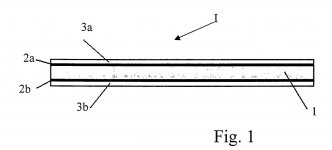
[0045] A pore filler 2a, 2b is applied to this core 1, on which there is a coating 3a, 3b made of resin and a textile material, which is referred to below as the top layer. The pore filler 2a, 2b and the coating 3a, 3b are on opposite sides of the core, respectively upset. Alternatively, the coating 3a, 3b can be applied directly to the core 1 or a coating 3a can only be provided on one side of the core 1, with a pore filler 2a being able to be located between this one coating 3a and the core 1.
And some place earlier,
By impregnating the core with pore filler before coating with the textile material and the resin, absorption of the resin and adhesion problems are avoided.
Steve -
On holiday with rain and now a mild case of Covid, I started entertaining myself watching odd YouTube videos.
To my mind, both of these videos essentially describe homemade composites.
One advocating cotton and super glue the other graphite and super glue.
In the graphite focused video, the graphite itself serves as a structure for these DIY composites.
One can readily purchase graphite powder. Pretty cheap.
From other research I understand that graphite can increase the working time of super glue, but probably not sufficiently so to coat anything, but a small panel.
Also, super glue outgases toxic fumes when one works with it.
This has me wondering....
Why not add graphite to PVA in coating various types of panels (e.g., balsa, EPS, 3mm plywood)?
The PVA should bond the graphite particles together.
The graphite should provide the molecular structure and a harder and stronger surface.
While not a home made carbon fiber composite sheet/fabric, this approach could provide many of the benefits of such sheets, while remaining, thinner, lighter, easier to work, and less expensive.
It might even prove better for DML purposes than trying to laminate carbon fiber sheets or cloth to a lightweight core material.
Could produce a cool black DML.
Another possible structural fiber one could try:
Probably not as strong a graphite, but easily available keratin fibers have a larger size (especially in length) than powdered graphite.
Not home in my workshop so I can't try these idea, but I thought them worth sharing.
Back to YouTube surfacing ;-)
P.S. I may have a source for carbon fibers used to make carbon fiber sheets, cloth, and composites. I haven't found it readily available the the general public, but I know someone in the industry. I'll keep the tread posted.
On holiday with rain and now a mild case of Covid, I started entertaining myself watching odd YouTube videos.
To my mind, both of these videos essentially describe homemade composites.
One advocating cotton and super glue the other graphite and super glue.
In the graphite focused video, the graphite itself serves as a structure for these DIY composites.
One can readily purchase graphite powder. Pretty cheap.
From other research I understand that graphite can increase the working time of super glue, but probably not sufficiently so to coat anything, but a small panel.
Also, super glue outgases toxic fumes when one works with it.
This has me wondering....
Why not add graphite to PVA in coating various types of panels (e.g., balsa, EPS, 3mm plywood)?
The PVA should bond the graphite particles together.
The graphite should provide the molecular structure and a harder and stronger surface.
While not a home made carbon fiber composite sheet/fabric, this approach could provide many of the benefits of such sheets, while remaining, thinner, lighter, easier to work, and less expensive.
It might even prove better for DML purposes than trying to laminate carbon fiber sheets or cloth to a lightweight core material.
Could produce a cool black DML.
Another possible structural fiber one could try:
Keratin is one of a family of structural fibrous proteins also known as scleroproteins. Alpha-keratin is a type of keratin found in vertebrates. It is the key structural material making up scales, hair, nails, feathers, horns, claws, hooves, and the outer layer of skin among.
- Wikipedia
Also available readily in a number of forms, e.g., Keratin fibers.Probably not as strong a graphite, but easily available keratin fibers have a larger size (especially in length) than powdered graphite.
Not home in my workshop so I can't try these idea, but I thought them worth sharing.
Back to YouTube surfacing ;-)
P.S. I may have a source for carbon fibers used to make carbon fiber sheets, cloth, and composites. I haven't found it readily available the the general public, but I know someone in the industry. I'll keep the tread posted.
- Home
- Loudspeakers
- Full Range
- A Study of DMLs as a Full Range Speaker
